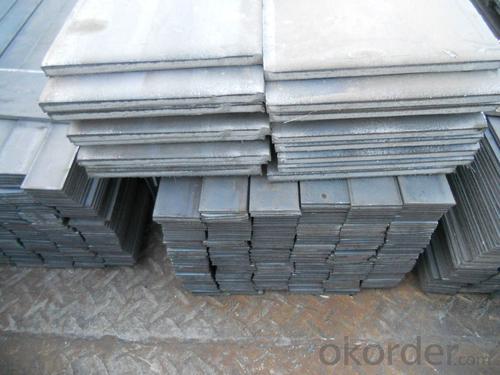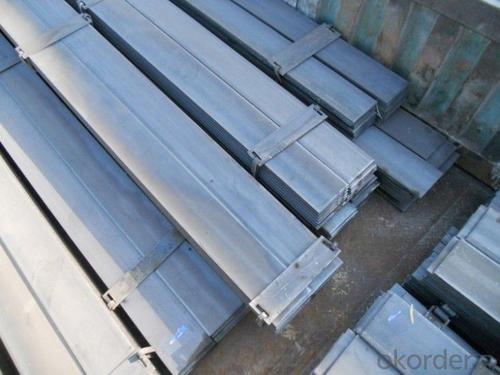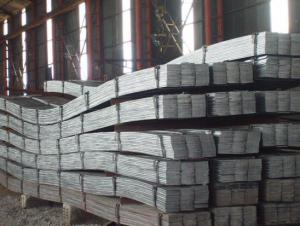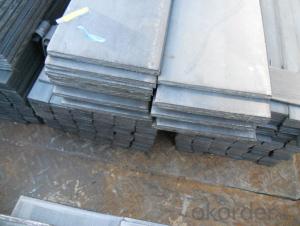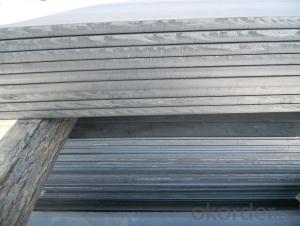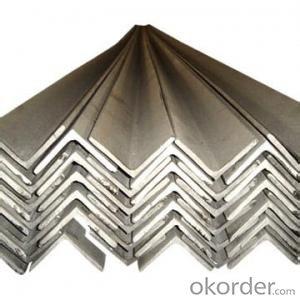Hot Rolled Flat Bars with High Quality in Material Grade Q235
- Loading Port:
- Tianjin
- Payment Terms:
- TT OR LC
- Min Order Qty:
- 25 m.t.
- Supply Capability:
- 10000 m.t./month
OKorder Service Pledge
OKorder Financial Service
You Might Also Like
Product Description:
OKorder is offering high quality Flat Bar at great prices with worldwide shipping. Our supplier is a world-class manufacturer of steel, with our products utilized the world over. OKorder annually supplies products to European, North American and Asian markets. We provide quotations within 24 hours of receiving an inquiry and guarantee competitive prices.
Product Applications:
Flat Bars are ideal for structural applications and are widely used in the construction of buildings and bridges, and the manufacturing, petrochemical, and transportation industries.
Product Advantages:
OKorder's Flats Barare durable, strong, and resist corrosion.
Main Product Features:
· Premium quality
· Prompt delivery & seaworthy packing (30 days after receiving deposit)
· Corrosion resistance
· Can be recycled and reused
· Mill test certification
· Professional Service
· Competitive pricing
Product Specifications:
Manufacture: Hot Rolled
Grade: Q195 – 235
Certificates: ISO, SGS, BV, CIQ
Length: 6m – 12m, as per customer request
Packaging: Export packing, nude packing, bundled
Chemical composition of Q235
Alloy No | Grade | Element(%) | ||||
C
| Mn
| S
| P
| Si
| ||
Q235
|
B
|
0.12—0.20 |
0.3—0.7 |
≤0.045 |
≤0.045
|
≤0.3
|
Physical properties of Q235
Alloy No | Grade | Yielding strength point(Mpa) | Tensile strength (Mpa) | Elongation after fracture(%) | ||||||
Thickness (mm) | Thickness (mm) | |||||||||
≤16 | >16--40 | >40--60 | >60--100 | ≤16 | >16--40 | >40--60 | >60--100 | |||
≥ | ≥ | |||||||||
Q235 |
B |
235 |
225 |
215 |
205 |
375--500 |
26 |
25 |
24 |
23 |
FAQ:
Q1: How soon can we receive the product after purchase?
A1: Within three days of placing an order, we will begin production. The specific shipping date is dependent upon international and government factors, but is typically 7 to 10 workdays.
Q2: How do we guarantee the quality of our products?
A2: We have established an advanced quality management system which conducts strict quality tests at every step, from raw materials to the final product. At the same time, we provide extensive follow-up service assurances as required.
Q3: The products are invoicing on theoritical weight or on actual weight?
A3: We can do it in both manners, according to the customers' request.
Images:


- Q: What are the standard lengths of steel flat bars?
- The lengths of steel flat bars can differ depending on the manufacturer and project specifications. Nonetheless, there are widely utilized standard lengths in the industry. These standard lengths usually fall between 6 and 20 feet. Longer lengths, like 24 feet or custom sizes, may be available from certain manufacturers, but they are not as commonly employed. It should be noted that steel flat bars can be cut and tailored to meet specific project requirements.
- Q: Are steel flat bars recyclable?
- It is true that steel flat bars can be recycled. Steel is widely known as one of the most frequently recycled materials globally because of its inherent characteristics. Its quality and strength remain intact even after being melted down and repurposed numerous times. By recycling steel flat bars, not only do we contribute to the preservation of natural resources, but we also decrease energy usage and greenhouse gas emissions compared to the production of new steel from raw materials. Recycling centers and scrap yards are available for accepting steel flat bars, providing an environmentally friendly alternative for disposing or repurposing these materials.
- Q: Are steel flat bars suitable for structural support?
- Steel flat bars are a suitable choice for structural support in various applications. Steel is renowned for its strength and durability, making it an excellent material for providing structural support. Particularly, flat bars have a broad range of uses in construction and engineering projects. They can serve as beams or columns to bear heavy loads, act as braces to reinforce structures, or function as connectors to unite different components. Steel flat bars are often favored over alternative materials for structural support due to their exceptional strength-to-weight ratio, resistance to corrosion, and adaptability in design and installation. Nevertheless, it is crucial to ensure that the steel flat bars used meet the specific application's necessary specifications and requirements to guarantee the structure's safety and stability.
- Q: How are steel flat bars measured?
- Steel flat bars are typically measured by their width and thickness. The width refers to the horizontal dimension of the bar, while the thickness refers to the vertical dimension. Both measurements are usually expressed in millimeters or inches. For example, a steel flat bar might be specified as 50 mm wide and 5 mm thick. These measurements help to determine the overall size and shape of the bar, allowing it to be accurately used in construction, manufacturing, or other applications.
- Q: Can steel flat bars be drilled or tapped easily?
- Yes, steel flat bars can be drilled or tapped easily. Steel is a versatile material that can be machined using various tools and techniques. Drilling holes in steel flat bars can be done using a drill press or handheld drill with the appropriate drill bit. Similarly, tapping threads into steel flat bars can be achieved using a tap and die set. However, the ease of drilling or tapping may vary depending on the thickness and hardness of the steel. Thicker and harder steel bars may require more power and specialized tools for drilling or tapping. Additionally, using cutting fluids or lubricants can improve the ease and efficiency of the drilling or tapping process.
- Q: How do steel flat bars contribute to the overall sustainability of a project?
- Steel flat bars contribute to the overall sustainability of a project in several ways. Firstly, steel is a highly durable material, and flat bars made from steel are no exception. They have a long lifespan and can withstand harsh environmental conditions without deteriorating. This durability reduces the need for frequent replacements, leading to less waste generation and a lower environmental impact. Secondly, steel flat bars are recyclable. When a project reaches the end of its life cycle, these bars can be easily recycled and repurposed for other applications. This reduces the demand for virgin steel production, which is a highly energy-intensive process that contributes to greenhouse gas emissions. By choosing steel flat bars, projects can support a circular economy by promoting the reuse and recycling of materials. Furthermore, steel is known for its strength-to-weight ratio, meaning it can provide structural support while using minimal materials. This efficiency in design reduces the overall footprint of a project and minimizes the consumption of resources. It allows for lighter and more sustainable structures, which can result in lower energy consumption during construction as well as reduced ongoing maintenance and operational costs. Lastly, steel flat bars are versatile and can be used in a wide range of applications, from architectural designs to infrastructure projects. Their versatility contributes to the overall sustainability of a project by allowing for flexible and efficient construction methods. This adaptability reduces material waste and optimizes resource utilization. In conclusion, steel flat bars contribute to the overall sustainability of a project by offering durability, recyclability, efficiency in design, and versatility. By incorporating steel flat bars into construction projects, we can minimize waste generation, reduce energy consumption, and promote the reuse and recycling of materials, ultimately contributing to a more sustainable built environment.
- Q: Can steel flat bars be used for manufacturing agricultural machinery?
- Yes, steel flat bars can be used for manufacturing agricultural machinery. Steel is a versatile and strong material that is commonly used in various industries, including agriculture. Steel flat bars offer several advantages such as high strength, durability, and resistance to corrosion, making them suitable for agricultural machinery. They can be used in the fabrication of equipment like plows, harrows, cultivators, and seeders, providing the necessary structural support and stability. Additionally, steel flat bars can be easily welded, bent, and formed into different shapes, allowing for customization and efficient manufacturing of agricultural machinery. Overall, steel flat bars are a reliable and cost-effective choice for manufacturing agricultural machinery due to their strength, durability, and versatility.
- Q: How do steel flat bars perform in terms of thermal conductivity?
- Steel flat bars have a relatively high thermal conductivity compared to other materials. This means that they are quite efficient in conducting heat. When exposed to high temperatures, steel flat bars quickly absorb and distribute heat throughout their structure. Conversely, steel flat bars also dissipate heat efficiently, allowing them to cool down rapidly. This property makes steel flat bars suitable for various applications where thermal conductivity is important, such as in the construction industry, where they are commonly used in heat transfer systems, heat exchangers, and other thermal management applications.
- Q: Can steel flat bars be used in the oil and gas industry?
- Certainly, steel flat bars have the potential to find utility within the oil and gas industry. Given their robustness and longevity, steel flat bars are widely employed across diverse sectors. In the realm of oil and gas, these bars serve numerous purposes including bolstering, framing, platform construction, and the creation of structural elements. Typically, these bars are crafted from either carbon steel or alloy steel, both of which exhibit exceptional resistance to corrosive substances, elevated temperatures, and intense pressure. Furthermore, steel flat bars lend themselves well to welding and can be skillfully fabricated to align with specific project prerequisites, rendering them an apt choice for the oil and gas industry.
- Q: Do steel flat bars have a specific melting point?
- Steel flat bars do not have a specific melting point, as the melting point of steel depends on its composition. Steel is an alloy made primarily of iron and carbon, but it can also contain other elements such as manganese, chromium, nickel, and more. Each of these elements affects the melting point of steel. Generally, the melting point of most steel alloys falls within the range of 1370 to 1530 degrees Celsius (2500 to 2800 degrees Fahrenheit). However, it is important to note that different types of steel have different melting points, so there is no one-size-fits-all answer to this question.
Send your message to us
Hot Rolled Flat Bars with High Quality in Material Grade Q235
- Loading Port:
- Tianjin
- Payment Terms:
- TT OR LC
- Min Order Qty:
- 25 m.t.
- Supply Capability:
- 10000 m.t./month
OKorder Service Pledge
OKorder Financial Service
Similar products
Hot products
Hot Searches
Related keywords



